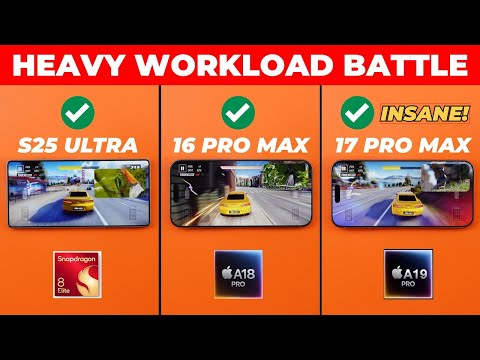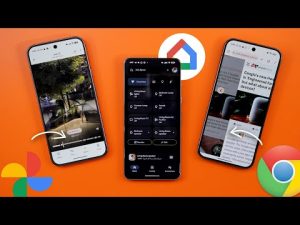
The 17 Pro Max is here with its one-of-a-kind vapor chamber, the latest A19 Pro chip, and the new aluminum unibody that should help in heat dissipation. Apple took dramatic decisions to make sure its latest and the greatest iPhone delivers the best sustained performance. So, how big is the difference when compared to its predecessor and the competition? To answer this question, let's do a heavy workflow test. [Music] In this video, I will compare the all new 17 Pro Max versus the winners of my last round, the S25 Ultra and the 16 Pro Max. But before starting, let's run some benchmarks to see how it stacks against the competition.
It's also worth noting that this is the heavy workload test cosmic orange edition featuring this new backdrop that matches my 17 Pro Max's color. Starting with Geekbench 6, the A19 Pro chip is 12 and 11% faster than the 16 Pro Max and the S25 Ultra respectively in the multi-core score. Plus, it's 10 and 31% faster in the single core. Moving to 3D Mark, I did two tests this time. The first one is the Wildlife Extreme. The 17 Pro Max is a tiny bit better than the S25 Ultra and 19.8% faster than the 16 Pro Max. The second one is Solar Bay Extreme to test the rate tracing performance. You will notice that the 17 Pro Max is the fastest by a good margin followed by the 16 Pro Max and the S25 Ultra is the slowest which is also reflected on the numbers.
The 17 Pro Max is 54 and 115% faster than the 16 Pro Max and the S25 Ultra respectively, which is insane. So, enough with the numbers and let's prepare for the test. If you are new here, I put the phones under a heavy workload by running four heavy tasks simultaneously for 30 minutes as shown now on the screen. The phone that finishes the test without any crashes or thermal warning wins. And now let's set the rules. The iPhones are running the latest stable version of iOS 26, but the 17 Pro Max's build number is different.
Also, the S25 Ultra is now running the stable 1 UI 8. It's also worth noting that the 16 Pro Max and the S25 Ultra were running the beta versions in my previous test and both made it till the end. So, let's see if things are now better or worse. All phones are using cellular data with 5G set to auto. The screen resolution on the Galaxy is maxed out while the iPhones have the same exact fixed resolution. Additionally, the iPhones have the new adaptive power mode activated and the battery capacity is 100% on both. Last but not least, all phones are set to 120 Hz refresh rate and the screen brightness is calibrated on the same light meter. And now let's begin the test. All phones started with 80% battery and the initial temperatures from left to right are 30.2° C, 28.2, and 29° with no apps running in the background.
I will start by initiating a Microsoft Teams meeting with the screen sharing enabled. You can see the screen sharing performance of each one on the secondary phone. Then I will play a 2160p video on YouTube in pictureand picture view. Then start the navigation to Dubai mode in Google Maps. And finally play Asphalt Unite. Before starting the stopwatch, let me show you that the game is set to 60 fps on all phones and the graphics are maxed out.
Now it's time to start and let's see what's going to happen. Right off the bat, all deliver the same graphics equality. The 17 Pro Max has the best screen sharing performance, followed by the 16 Pro Max and the S25 Ultra is barely moving, but the iPhones lost some of their screen brightness in the preparation phase with the 16 Pro Max being the darkest and the S25 Ultra is the brightest, while the 17 Pro Max is somewhere in between.
So, let's fast forward until something interesting happens. After 4 minutes and 36 seconds, the S25 Ultra had its first brightness drop and started to slowly dim the display. It looks about the same as the 17 Pro Max now. While the 16 Pro Max remains in the third spot, the screen sharing performance remains the same as the last checkpoint, the 17 Pro Max is first, followed by its predecessor, while the S25 Ultra is far behind. Shortly after, at the 6 minutes and 9 seconds mark, the S25 Ultra started to dim them the display again.
Now it's the darkest, while the 17 Pro Max took the lead, and the 16 Pro Max is somewhere in between. Performance-wise, nothing changed. Here's another look at the performance and the brightness of all three in the same race to get an idea about the differences. All perform as good as the last checkpoint. So, let's keep going. After 10 minutes and 17 seconds, the 17 Pro Max paused the YouTube video. I decided to give it a minute to get back on track before calling it a failure, giving it the benefit of the doubt that it could be a network issue. While waiting for the 17 Pro Max to resume the playback, the 16 Pro Max had a big brightness drop 28 seconds after this incident to be the darkest once more. After a total of 36 seconds, the 17 Pro Max resumed the playback. Other than this, it is still the brightest. Plus, the game and the screen sharing are still running smoothly. So, let's keep going. 3 minutes later, the 17 Pro Max had its big brightness drop, same as its predecessor.
Now, the screen brightness match, and the S25 Ultra is back to the lead. When you look closely at the game, you will see that the 17 Pro Max is a lot smoother when compared to the jittery performance of the 16 Pro Max that has some small pauses every now and then. Plus, it is still delivering an impressive screen sharing performance, which is noticeably better than its predecessor. When it comes to the S25 Ultra, the game is running smoothly, unlike its worst screen sharing performance that Burnley moves. It also had its third brightness drop at the 14 minutes and 50 seconds mark. That makes it very close to the iPhones, but a tiny bit brighter. So, let's fast forward to the next checkpoint. At the 19 minutes and 38 seconds mark, the S25 Ultra had its fourth and last brightness drop.
Now, all three look identical. The 17 Pro Max and the S25 Ultra delivered the same smooth game performance. Unlike the 16 Pro Max that still suffers from these small pauses, the 17 Pro Max remains the screen sharing king, followed by the 16 Pro Max and the S25 Ultra comes last as usual. Thankfully, all three did finish the whole 30 minutes in this round. So, let me fast forward to the end to give you one final look at the performance before wrapping up. So, here is how they look. The 17 Pro Max and the S25 Ultra still have the best game performance, followed by the 16 Pro Max, and the screen sharing ranking is exactly the same as the lost checkpoint. Now the 30 minutes are over. Starting with the battery, the 17 Pro Max consumed only 8% which is insane. This is the first time for me to see this number. The 16 Pro Max comes second with 12% and the S25 Ultra is third with 14%. Temperature- wise, the 17 Pro Max comes first as well. It maxed out at 42.2° C. Keep in mind that the thermometer shows higher numbers briefly until it adjusts itself.
So, I take the most stable readings. The S25 Ultra comes second with 44° and the 16 Pro Max is the hottest at 46°. And now, let's sum up the numbers. All three passed the 30 minutes with the same graphics quality. In the game play, the S25 Ultra and the 17 Pro Max were equally good, followed by the 16 Pro Max that was a bit laggy. The S25 Ultra had the brightest display most of the time, followed by the 17 Pro Max, and the 16 Pro Max comes third.
In contrast, the 17 Pro Max had the best screen sharing performance, followed by the 16 Pro Max, and the S25 Ultra comes third. But what's impressive here is the 17 Pro Max's thermal management. It reached 42.2° 2° which is the lowest number I have seen in this test. The S25 Ultra was the second best at 44° and the 16 Pro Max comes third with 46°. Another record to the 17 Pro Max is the battery usage. It only consumed 8% battery which is the first to see in this test as well. The 16 Pro Max is the second best with 12%. And the third spot goes to the S25 Ultra with 14%. That gives the overall win to the 17 Pro Max with two new records in the battery and thermals.
The S25 Ultra comes second and the 16 Pro Max takes the third spot. By this, I'm done with my heavy workload test and please let me know what do you think in the comments. But for now, thanks so much for watching and see you in the next.


